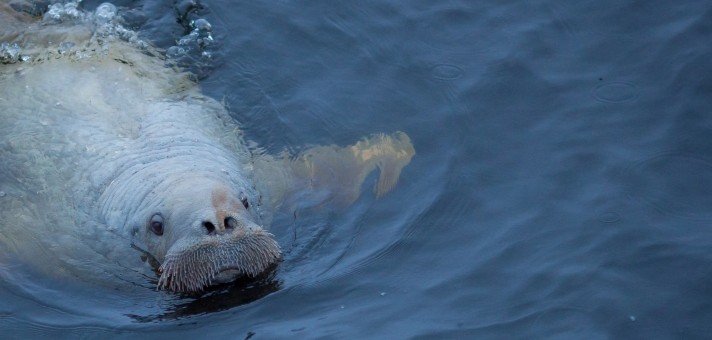Head of the laboratory Doctor in Biology Nikolay N. Kavtsevich
Brief History
The laboratory of marine mammals was founded on the decision of the Presidium of Academy of Sciences of the USSR Kola branch on August 30, 1984, in which following main scientific directions of laboratory's work were determined:
- development of requirements to complexes of technical means and methods for long-term maintenance and life support of marine mammals in conditions of mariculture on Murman;
- studies of morphology, physiology and behavioral characteristics of marine mammals;
- studying of possibilities of using behavioral and physiological features of marine mammals.
Main areas of research:
- morphology, physiology and behavior features of marine mammals; study of modern distribution and abundance of cetaceans and pinnipeds in the Arctic seas;
- biology and ecology of individual pinniped species, which are of special interest in connection with their status.
Main objects of research are key species - harp seal and ringed seal, as well as rare and protected - gray and ordinary seals, polar bear.
The laboratory activity is carried out on the basis of an integrated approach to study animals, which is provided by the use of various research methods that allow us to characterize different levels of the living organization - from molecular-cellular to population.

Main achievements of laboratory:
-
The range of plasma and blood cell parameters variability of harp seals in ontogenesis was determined for the first time. Adverse tendencies in the White Sea population structure of this pinniped species in terms of the metabolic and immunological adaptations level have been revealed (Kavtsevich, Erokhina, 1996; Erokhina, Kavtsevich, 1998).
-
Comparative study of sea hare, ringed seal, gray and harp seals food-producing behavior caused by visual and auditory signal stimuli was carried out for the first time. It is established that seals are significantly different in speed and strength of motor conditioned alimentary reflexes development. These differences are determined both by individual experience and specific ecological features of animals. Gray seals show a high level of ability to generalize when selecting objects based on a relative sign of similarity or difference (Berezina, Kavtsevich, 2004, 2011; Berezina, 2012, Kavtsevich, Mihailuk, Berezina, Yurko, 2007; Berezina, Kalinin, 2013; Berezina, 2013).
-
A comparative morphological and morphometric study of nucleolus organizers regions of lymphocytes in peripheral blood of marine mammals of seven species was carried out. A basis has been created for assessing changes in the most important part of the genome associated with synthesis of proteins, in ontogenesis, in diseases, in various physiological states in cetaceans and pinnipeds. The qualitative and quantitative characteristics of nucleolus organizers regions for staining with silver in lymphocytes of Greenland and gray seals, sea hare, ringed seal, bottlenose dolphins, ordinary sea pigs, beluga (Kavtsevich, Yurko, 2007, Minziuk, Kavtsevich, 2009, Kavtsevich, 2010).
-
It is established (Erokhina, Kavtsevich, 2007) that the osmotic resistance of erythrocytes in seals is lower than in terrestrial animals and humans, which is due to peculiarities of their membranes lipid composition and is associated with a higher permeability for low-molecular substances (including oxygen).
-
For the first time in natural conditions and in captive adapted seals, there was an equalization at certain stages of individual development of lymphocytes and neutrophils number - the "physiological cross" of the leukocyte blood formula, caused by the formation of a system of specific immunity. It was found that changes in cellular blood composition of seals at early stages of adaptation to conditions of captivity (3 weeks) are largely due to stress. The blood composition is stabilized after 10-12 months of adaptation (Kavtsevich, Erokhina, 2003, 2009, Kavtsevich et al., 2007; Kavtsevich, 2011).
-
Spontaneous arrhythmia of cyclic processes, prolonged respiratory pauses are realized not only in cases when this is vitally necessary, i.e. in the aquatic habitat, but also during the time animals are in the air has been established as a result of physiological and behavioral signs of gray and harp seals adaptation study to a diving lifestyle (Kavtsevich et al., 2007; Voinov, Kavtsevich et al., 2008).
-
Morphological and cytochemical study of peripheral blood of bladder-nose seal puppies completed the milk feeding cellular composition was undertaken for the first time. The formation of hematopoietic system in this period of ontogeny in seals, in contrast to terrestrial vertebrates, has not yet been (Minzyuk, Kavtsevich, 2010).
-
Indicators of bactericidal activity of phagocytic leukocytes were studied in pinnipeds for the first time (by the example of a gray seal). A lower level of natural nonspecific resistance in seals compared to terrestrial mammals, as well as a change in oxygen-dependent (myelopeoxidase) and oxygen-independent (cationic proteins) ratio of its links with age was detected (Minzyuk, Kavtsevich, 2012, 2013).
Extensive material has been accumulated that characterizes physiological status of pinniped species number in the norm and under the influence of various environmental factors, as a result of Arctic seals studies both in the natural habitat and in captivity, (Kavtsevich et al., 1992; Kavtsevich, Erokhina, 1996 Erokhina, Kavtsevich, 1998; Erokhina, 1999; 2002; 2003; Kavtsevich et al., 2007; Erokhina, Kavtsevich, 2011, Kavtsevich, 2011; Minzyuk, Kavtsevich, 2013, 2014; Minzyuk, Kavtsevich, Svetochov, 2014 and others). New directions in research of Arctic animals - ecological biochemistry and hematological cytochemistry of marine mammals are formed.
The creation of generalizing works devoted to the harp seal (Mishin et al., 2001), ringed seal (Ognetov et al., 2003, Svetocheva, Svetochiv, 2010), beluga (Matishov, Ognetov, 2006) is among the most important achievements of the laboratory staff. One of the most important results of expeditionary theriological studies along the Northern Sea Route is boundaries specification of the hummock seal geographic distribution (Vorontsov, 2002). Observational results of polar bears along the route from the side of nuclear icebreakers and motor ships are presented in monographs (Matishov et al, 2000, 2013). New data have been obtained on the distribution, migration, abundance and nutrition of marine mammals in the Barents, White and Kara Seas (Svetochov, Svetochova, 2007-2014). Migrations of harp seal pups of the first year of life (Svetochov, Kavtsevich, 2011, Svetochov, 2013) are investigated for the first time with the help of satellite telemetry sensors (DTS). DTS are also used in studies of ringed seals, and gray seal (Svetochev et al., 2010) and sea hare.
Laboratory staff
Kavtsevich Nikolay Nikolaevich (in Russian)
Erokhina Irina Anatol’evna (in Russian)
Svetocheva Olga Nagimovna (in Russian)








